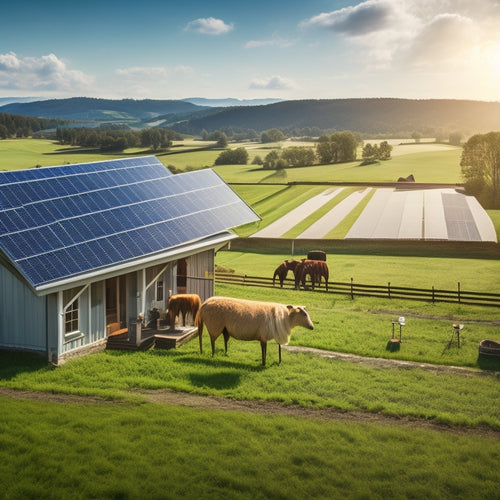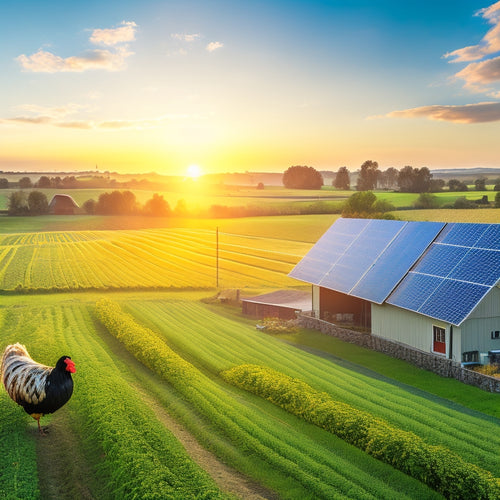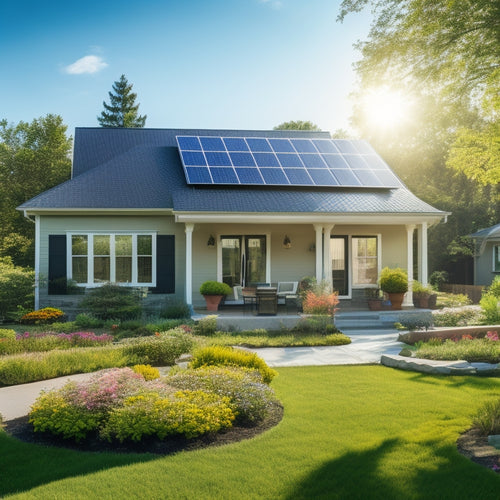
What Qualifies as a Large Residential Solar System?
Share
You're evaluating a large residential solar system, which exceeds 10 kilowatts (kW) in capacity, ranging from 10 kW to over 100 kW. System size and capacity are determined by your energy needs, with factors like roof size, orientation, and local peak sun hours influencing the number of solar panels required. Accurate calculations are vital for proper inverter and battery sizing, ensuring efficient energy production. As you investigate large residential solar systems, you'll want to understand the complex design elements, installation and maintenance costs, and incentives that can offset higher upfront costs - and that's just the beginning of what you'll need to take into account.
Key Takeaways
- A large residential solar system exceeds 10 kilowatts (kW) in capacity, with sizes ranging from 10 kW to over 100 kW.
- System size is categorized as small, medium, or large based on capacity, with larger systems requiring hundreds or thousands of solar panels.
- The type of inverter selected for a large system depends on the system size and capacity, with complex designs involving multiple inverters or battery storage solutions.
- Large systems are typically designed for high-energy users, such as large homes, estates, or rural properties with significant energy demands.
- Accurate calculations of energy production needs and peak sun hours are crucial for designing and installing a large residential solar system.
Defining Large Residential Solar
Typically, a large residential solar system is defined as one with a capacity exceeding 10 kilowatts (kW).
You're likely interested in knowing what qualifies as a large system because you're considering installing one to power your home.
As you examine your options, you'll find that large residential solar systems often benefit from incentive programs designed to encourage the adoption of renewable energy.
These programs can help offset the higher upfront costs associated with larger systems.
You'll want to research the specific incentives available in your area, as they can vary considerably.
When designing a large residential solar system, grid integration is also an essential consideration.
Your system will need to be able to feed excess energy back into the grid and draw from it when needed, ensuring a reliable and efficient supply of power.
A well-designed system will seamlessly integrate with the grid, providing you with a consistent and sustainable source of energy.
System Size and Capacity
You'll need to evaluate system size ranges when designing a large residential solar system, as they can span from 10 kilowatts (kW) to over 100 kW.
The size of your system will directly impact the number of solar panels required, with larger systems necessitating hundreds or even thousands of individual panels.
System Size Ranges
As you plan your large residential solar system, the size and capacity of the system become critical factors to reflect upon. You'll need to determine the appropriate system size range to guarantee you're generating enough power to meet your energy needs.
Residential solar systems typically fall into three size ranges: small (2-5 kilowatts), medium (5-10 kilowatts), and large (10-20 kilowatts or more).
When selecting an inverter type, take into account the system size and capacity. For example, a string inverter may be suitable for smaller systems, while a microinverter or power optimizer might be more suitable for larger systems.
Additionally, if you're incorporating battery storage into your system, you'll need to assess the capacity of the batteries and how they'll interact with the solar array.
Larger systems often require more complex system designs and may involve multiple inverters or energy storage systems.
It's crucial to consult with a solar professional to ascertain your system is properly sized and configured to meet your energy needs and local building codes.
Solar Panel Quantity
Your solar panel quantity directly correlates with the system size and capacity, which in turn affects your energy production. The more solar panels you have, the larger the system size and capacity, resulting in increased energy production. However, the type and quality of solar panels also play a significant role in determining the overall system performance.
When it comes to selecting the right solar panel quantity for your large residential solar system, consider the following factors:
-
Efficiency: High-efficiency solar panels produce more power per unit area, reducing the number of panels needed to achieve your energy goals.
-
Panel size and wattage: Larger panels with higher wattage ratings can reduce the overall number of panels required.
-
Roof size and layout: The available roof space and layout can limit the number of panels that can be installed.
-
Energy requirements: Your energy consumption patterns and goals influence the number of panels needed to meet your energy demands.
-
Solar technology advancements: Advances in solar panel types, such as bifacial or perovskite panels, can impact the number of panels required to achieve the same energy output.
Energy Output and Consumption
You'll need to evaluate your daily energy demands to determine the system size requirements for your large residential solar system.
This calculation will involve analyzing your energy usage patterns and identifying the peak sun hours in your area to guarantee you're generating enough power to meet your needs.
Daily Energy Demands
Determining your daily energy demands is an essential step in sizing a large residential solar system, as it directly impacts the system's energy output and consumption.
You need to understand how much power your home requires on a daily basis to guarantee your solar system can meet those demands. This involves calculating your energy usage patterns, considering factors like energy efficiency and power management.
To get an accurate representation of your daily energy demands, reflect on the following:
- Your home's square footage and insulation
- The number and type of appliances, lighting, and HVAC systems
- Your energy usage habits, such as when you use the most power during the day
- The local climate and how it affects your energy needs
- Any energy-intensive devices or equipment, like pools or electric vehicles
System Size Requirements
With your daily energy demands in mind, the next step is to calculate the system size requirements, which involves determining the energy output and consumption of your large residential solar system.
To do this, you'll need to take into account the total energy load of your home, including your appliances, lighting, and HVAC systems. You'll also need to factor in your energy usage patterns, such as when you use the most energy during the day.
Based on these calculations, you can determine the required energy output of your solar system. This will help you select the right inverter type, which will convert the DC power generated by your solar panels into AC power for your home.
You may also want to think about battery storage to store excess energy generated during the day for use at night or during power outages. The type and size of your inverter and battery storage will depend on your specific energy needs and usage patterns.
Peak Sun Hours
Peak Sun Hours (Energy Output and Consumption)
When considering a large residential solar system, you need to think about peak sun hours, which affect energy output and consumption. Peak sun hours refer to the amount of solar radiation your location receives. This metric is vital in determining how much energy your solar panel system will produce.
To give you a better understanding, here are some key points to keep in mind:
-
Peak sun hours vary by geographic location, with areas near the equator receiving more solar radiation than those closer to the poles.
-
The amount of energy your solar panel system produces is directly proportional to the peak sun hours it receives.
-
A location with high peak sun hours can produce more energy with a smaller system, while a location with low peak sun hours may require a larger system to produce the same amount of energy.
-
Peak sun hours also impact the efficiency of your solar panel system, as higher temperatures can reduce energy output.
-
Understanding peak sun hours is essential to designing an ideal solar panel system that meets your energy needs.
Roof Size and Orientation
Most residential roofs have sufficient space to accommodate a solar panel system, but the size and orientation of your roof play vital roles in determining the system's potential output. A larger roof provides more space for solar panels, increasing the system's capacity and potential energy production.
However, the orientation of your roof is also significant. Ideally, your roof should face south, with a slope between 15 and 40 degrees, to maximize energy production.
It's essential to evaluate the roof materials and their impact on the system's performance. For instance, asphalt shingles and metal roofs are suitable for solar panels, while slate or clay tiles might require additional installation considerations.
You'll also need to conduct a shading analysis to identify potential obstructions, such as trees, chimneys, or vents, that could reduce energy production.
Number of Solar Panels Required
You've determined your roof's size and orientation are suitable for a solar panel system, now it's time to calculate the number of solar panels required to meet your energy needs. To do this, you'll need to assess several factors, including your energy usage, the type of solar panels you want to install, and the installation technique used.
Here are some key assessments to keep in mind:
-
Energy usage: Your daily energy consumption will greatly impact the number of solar panels you need. A larger system will be required to meet higher energy demands.
-
Solar panel types: Different solar panel types have varying wattage outputs, affecting the number of panels needed to meet your energy goals.
-
Installation technique: The way panels are installed, such as horizontal or portrait orientation, can impact the overall system size.
-
Shading and obstruction: Shading from trees, buildings, or other obstructions can reduce the system's efficiency, requiring more panels to compensate.
-
Local building codes and regulations: Compliance with local regulations may influence the system's size and design.
Installation and Maintenance Costs
As you move forward with your large residential solar system, installation and maintenance costs become a critical consideration. These expenses can greatly influence your overall investment and return on investment (ROI). It is crucial to understand the various installation expenses and maintenance fees associated with your system.
| System Size | Installation Expenses | Maintenance Fees (Annual) |
|---|---|---|
| 10 kW | $25,000 - $35,000 | $1,000 - $2,000 |
| 15 kW | $37,500 - $50,000 | $1,500 - $3,000 |
| 20 kW | $50,000 - $70,000 | $2,000 - $4,000 |
| 25 kW | $62,500 - $90,000 | $2,500 - $5,000 |
| 30 kW | $75,000 - $110,000 | $3,000 - $6,000 |
When calculating your installation expenses, consider factors such as the system's size, panel quality, and installation complexity. Maintenance fees, on the other hand, will depend on the frequency of inspections, repairs, and replacements. By understanding these costs, you can better plan your investment and guarantee a successful large residential solar system installation.
Frequently Asked Questions
Can I Install a Large Solar System on a Small Roof?
You can optimize roof space utilization by selecting high-efficiency solar panels with higher capacity per unit area, allowing you to install a larger system on a small roof, but it'll depend on your energy needs and local building codes.
How Long Does It Take to Recoup the Investment Cost?
You'll likely recoup your investment in 5-7 years, depending on your return on investment, local incentives, and financing options, such as loans or power purchase agreements, that can offset the initial cost of your solar system.
Do Solar Panels Work During a Power Outage?
As you wonder if solar panels work during a power outage, the answer is no, not unless you have solar energy storage and off-grid capabilities, which allow you to collect and store excess energy for later use, providing you with reliable power when you need it most.
Can I Sell Excess Energy Back to the Grid?
You can sell excess energy back to the grid through net metering benefits, which track your production and consumption. Many utilities offer energy buyback options, allowing you to offset your bills or even earn credits, depending on local policies and regulations.
Do Solar Panels Void My Roof Warranty?
As you gaze up at your roof, wondering about solar panels, remember: a reputable installer will guarantee a seamless installation, adhering to solar installation guidelines, so you won't void your roof warranty; in fact, a good installer will even provide additional warranty coverage, giving you peace of mind.
Conclusion
As you traverse the world of residential solar systems, you're likely wondering what constitutes a large installation. The answer lies in a combination of factors, not just the number of panels. Imagine a sprawling estate, its rooftop a sea of shimmering blue panels, utilizing the sun's energy like a modern-day Arcadia. A large residential solar system is one that produces 10-20 kilowatts of power, covering a roofspace of around 1,000-2,000 square feet, and comprising 30-60 panels. It's a significant investment, but one that can power an entire household, and then some.
Related Posts
-

Solar Power Systems for Rural Properties
Solar power systems offer a reliable and efficient energy solution for rural properties, allowing you to gain energy ...
-

Solar Power Advantages for Rural Communities
Solar power presents numerous advantages for rural communities. You can greatly reduce energy costs, potentially by u...
-

Affordable Solar Panels for Home Use
Affordable solar panels offer you a smart way to cut down on energy costs while promoting sustainability. With govern...


